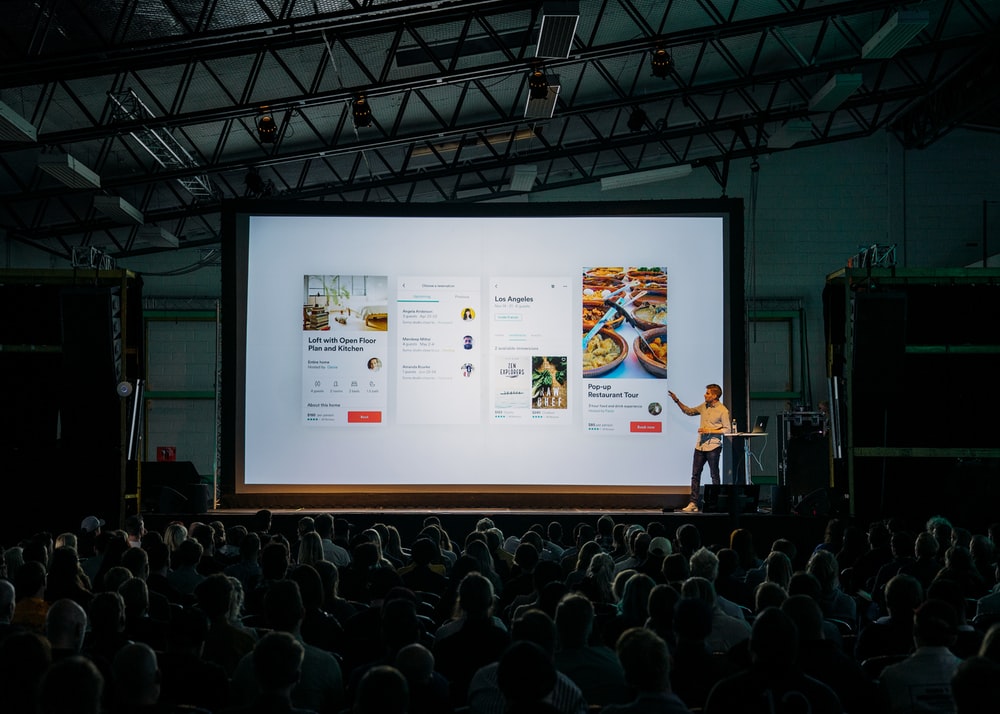
Before any talk, I know my material cold. I don’t read from slides. I don’t talk from notes or a script.
Some time in 2016, my lines crossed. I began making more money as a keynote speaker than I did as a marketing strategy consultant. (I have 20 sources of income but those two are the most important!)
The pull to host me as a keynote speaker has continued to climb over the years so I am becoming more serious about focusing on this as a major part of my business. It’s also caused me to sharpen my pencil and take a look at the economics being a keynote speaker.
If you’ve ever thought about becoming a professional speaker this is probably vital information for you, so let’s dive into this today.
The keynote speaker
First, what do I mean by “keynote” speaker?
A keynote speaker’s main purpose is to set the tone for the theme of an event. Selecting a keynote speaker who is well-known for his or her expertise in a field, or who has wide name recognition due to other accomplishments, raises enthusiasm among prospective attendees for an event.
The high-profile keynote speaking professional may lead off a conference or end it with a bang. Normally for a multi-day event there will be a keynote speaker for each day, and sometimes even a morning and evening keynote.
A keynote speaker has a starring role in the event, so there is a ton of pressure to deliver and make the organizers look like heroes.
As a keynote speaker, that is my goal. Total professionalism. Exceeding expectations. Creating positive buzz. Make my customers heroes.
It might seem like a glamorous life — show up to give a speech and collect the paycheck. But it’s a lot more involved than that. Here’s a peak behind the scenes:
Content development
A rule of thumb is that it takes about 20 hours of work to develop one hour of new content … not including practice! So if you ask me to create an entirely new speech, you will be receiving 20 hours of my effort at a minimum. A “standard” keynote speech (like Marketing Rebellion) took more than 80 hours of work since I do all my own slide graphics too.
This is why it is usually not feasible to ask somebody to create an entirely new speech for an event!
Some speakers wing it and furiously scramble to develop a talk the day before an event. I can’t do that. My talks are polished performances, so I have a set of four or five blockbuster talks that I can then tailor for an event. The speeches tend to morph and grow as I gain experience with the material, but the original talk takes an incredible amount of work.
So the first part of becoming a keynote speaker is developing the content — a minimum of 20 hours. And then comes the …
Customization
I never give the same speech twice. I research the organization, the industry, and the audience, and tailor my presentation to their specific issues and business language.
I’ll add localized examples, case studies, and event photos. I’ve even worked in mentions of the sponsors in some cases.
So, I’m not just pulling a speech out of my back pocket for my customers. I am giving three major speeches this week and all of them are customized for the individual events.
Including pre-calls with the organizers, customization may take another 2-3 hours of work per speech. I did one for the American Bar Association this summer that was easily six hours of custom work.
Practice
Before any talk, I know my material cold. I don’t read from slides. I don’t talk from notes or a script. I get up and tell a flowing story with humor and impact. And if it is supposed to last 45 minutes, it will last 45 minutes. Exactly. That does not just happen by chance.
I spend many hours standing alone in front of my computer screen practicing my delivery, my timing, and tweaking the content. I rehearse so much I am sick of myself.
For a new keynote speech, I’ll probably practice it 10-12 times before the first talk. I’m like an actor getting ready for a starring role. As I grow comfortable with the speech and deliver it every week I won’t need to rehearse so much. But I’m always adding and perfecting new elements.
Event support
Most organizations expect me to help promote their event and I’m happy to do this through tweets, posts, maybe even a guest blog post or interview. Sometimes I attend a client dinner, do a book signing, or help in other ways to add value and delight my customer. I don’t charge any more for this support. I average at least one hour of promotional support per speech.
Keynote speaker travel considerations
Travel is a HUGE factor in the economics of being a keynote speaker. I’m not talking about expense — that is typically covered by the organizers. But the TIME it takes to get to a location can be a killer because while you’re traveling, you can’t be doing something else that makes money.
The distance and flight schedule is an important consideration. This is why international events are a challenge. I always try to organize at least three events in the region of the world before I commit to an international speech. My average door-to-door travel time for a U.S. keynote engagement is 10 hours, roundtrip. That has to be factored into your speaking fee.
Business expenses for keynote speaker
There are certain uniques expenses to this profession that also add to the cost and economics of being a professional speaker. Having a great website is a must. Creating an effective “reel” of speaking highlights is a must — and not cheap! Managing the booking, transportation, billing, and often book sales takes a high administrative toll.
I also have a professional speaking agent (the fabulous Michelle Joyce) who earns a monthly fee plus a percentage of my earnings. It’s not appropriate to talk about those specifics, but it is a considerable amount in the total economics.
So when you establish a speaking fee, you have to factor in all these types of expenses.
Captured content
This is a subtle yet important aspect of public speaking — with the ease and expectation of sharing content all over the social channels, the value of your original material declines bit by bit. The value of my talk goes down every time it is posted on YouTube or Slideshare because the presentation is no longer a rare commodity — it’s out there for the world to see. That’s why many top speakers refuse to be recorded. I usually cooperate with the needs of event organizers but every time I do, it slowly nicks away at the value of the talk.
So let’s add up the economic costs of creating and delivering a new, one-hour keynote presentation:
- Content development – between 20-80 hours depending on the talk
Customization and research – 2-3 hours
Practice – 10-12 hours
Event support – 3 hours
Travel – 10 hours
Other costs like tech, admin, speaker representation
Actual presentation time – 1 hour
So you can see … it’s not just a speech. It’s a business machine!
I enjoy being a keynote speaker because I can deliver a ton of value in a short amount of time. And all the work is worth it. It can be a very profitable profession and so rewarding when you receive feedback like this:
”Mark Schaefer is my new favourite speaker. Such a warm, entertaining and informative presenter. Wow”.
”Every sentence @Markwschaefer speaks is a lesson of its own. What. A. Guy”.
Yup. Pretty cool. I love what I do and if this is what you want to do someday too, I hope this article has helped.









